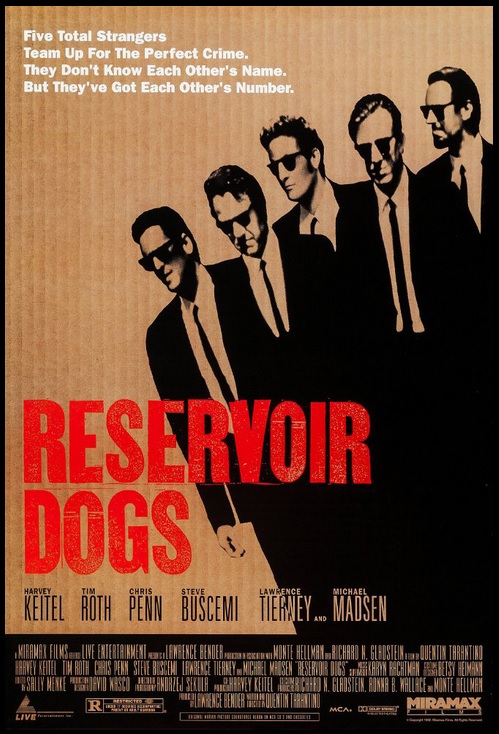While a formally educated and cinematically well-rounded film critic viewing Tarantino’s oeuvre will level accusations of plagiarism, schleps like me, who attended the Community College of Film Criticism with Quentin Tarantino, i.e., the local video store, realize Quentin crafts youth-inspired homage. He, like this writer and most of the B&S Movies’ readers, are graduates of the Video Fringe Educational System and our former classmate made it to the top of Mount Lee.

It was during my first Friday night class with Professor Q at my local triplex—in an empty theatre with less than a dozen-filled seats—when I pledged to always buy a ticket to a Tarantino film seminar: The minute I heard the color-aliases (Mr. Pink, White, etc.) assigned by Lawrence Tierney to his diamond heist crew, my brain’s film centers crossed referenced the awesome 1974 crime thriller by Joseph Sargent: The Taking of Pelham One Two Three—a film I went to see at the Drive-In with my parents as a wee lad (and watched every UHF-TV replay). For me, Joseph Sargent is the man: He’s the director of two of my all-time favorite films: Colossus: The Forbin Project and Burt Reynolds’s White Lightning (part of B&S Movies’ upcoming Redneck Week).
“I can’t believe you made me sit out in the lobby all alone and you finished watching the movie!” my soon-to-be-ex-girlfriend screeched. Yep, Tarantino drove her, and four other people, out of the theatre during the Steelers Wheel chair-torture scene.
Yep, Tarantino is the Walrus. He’s one of us and we are he and, when I sit in the theatre with one of his films, we, the video store geeks of ‘80s, are all together.
Once I learned Tarantino “plagiarized” Stanley Kubrick’s film noir, The Killing, 1952’s Kansas City Confidential, 1955’s The Big Combo, 1966’s Django (Italian Spaghetti Westerns? Where’s my plate!), and Ringo Lam’s City on Fire (1987) in the frames of Reservoir Dogs—I sought out those films. And that’s where the Tarantino-cool comes in: Outside of Pelham, how many of us seen or heard of these other films? How many of us rented those movies after their alignment with Tarantino? How many of us sought out more Lawrence Tierney film noirs?
The tale of the Reservoir Dogs is fairly simple and familiar: Eight men meet at a diner for breakfast before a big diamond heist. The heist goes bad and the ‘Dogs rendezvous at a warehouse. Paranoia reigns supreme until there’s one man left standing.
In the hands of any other director, confined in a one-set scene that plays out for the remaining 80-plus minutes, we’d be heading to the concession stand for a popcorn refill and reaching for fast forward button. Ah, but this is a Tarantino picture. Instead of cardboard characters in a cardboard situation on a cardboard set of the Ed Wood-Bela Lugosi variety, we get:
— Characters debating the philosophical meaning of Madonna’s song catalog
— A lesson on the art of tipping waitresses
— The characters readying for their heist to the sounds of an obscure and forgotten Norwegian band, the George Baker Selection
— A maudlin-monotone DJ on an all-‘70s radio station expounding on the career of Scottish musicians Joe Egan and Gerry Rafferty as Michael Madsen does a soft shoe and mutilates a chair duct-taped cop
— Lawrence Tierney, and Harvey Keitel from Taxi Driver, and Steve Buscemi
And that’s the art of Tarantino: he’s the master of the art of layers, as taught by screenwriting guru Robert McKee. Tarantino is the Sensei of pop-culture references; the master of actor casting; the definitive faux-radio station program director.
Think of all of the films produced across the decades with the same master plots churned over and over again by the Tinsel Town sausage machines. Tarantino knows us; he knows his fellow movie goers and video renters have been done’d-there-and-done’d-that to death. He knows we’ve seen those heist movies where “Murphy’s Law” reigns supreme. So he accessed his brain’s film databanks to create Reservoir Dogs, as well as other films, that, according to the ubiquitous film snob, may not be wholly original stories with original elements—but fail to realize Tarantino excels at creating the air of uniqueness with his end product. Tarantino is like oxygen: If you get too much, you get to high. Not enough, and you’re gonna die. It’s the sweet air I breathe.
It is my sincere hope this Tarantino ass-kiss week at B&S Movies convinces Quentin to do for our Italian post-Apocalyptic heroes, Mark Gregory and Michael Sopkiw, as he did for John Travolta: Cast them in a “comeback film,” as they both deserve to be Tarantino’d to the big screen—in a snow-drizzled, bloody fight scene against a hoard of black-suited Ninjas, backed by the music catalog of Sweet.
“And that was Brian Connolly and the Sweet on the station where the ‘70s survived, K-B-i-l-l-y, the Home of Rock,” speaker-croaks the maudlin-monotone DJ.
“Turn off the fucking radio, will you?” says Mark ‘Trash’ Gregory wiping the spoils of Asian blood from his brow. “That ‘70s bullshit gets on my fucking nerves.”
“Let’s get a taco,” says Michael ‘Parsifal’ Sopkiw clicking off the sounds of KBI radio as he peels away a blood-stained yellow jumpsuit.
In November 2022: Lionsgate reissued Reservoir Dogs for its 30th anniversary as a 4K UHD release, which we’ve reviewed. You can pick up your copy at Amazon, Best Buy, eBay, Mercari, Walmart, and Target.

About the Author: You can read the music and film reviews of R.D Francis on Medium and learn more about his work on Facebook. He also writes for B&S Movies.

Pingback: Pulp Fiction (1994) – B&S About Movies
Pingback: True Romance (1993) – B&S About Movies
Pingback: Exploring: Movies that influenced Quentin Tarantino – B&S About Movies
Pingback: Four Rooms (1995) – B&S About Movies
Pingback: My Best Friend’s Birthday (1988) – B&S About Movies
Pingback: The Hateful Eight (2015) – B&S About Movies